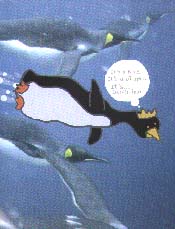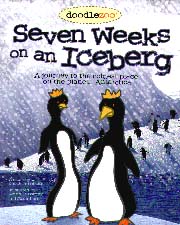|
________________
CM . . . .
Volume VII Number 7 . . . . December 1, 2000
excerpt: Antarctica is the land around the South Pole. It is one of the seven continents. It is mostly covered in ice. In the winter, which is long and dark, Antarctica is very, very, very cold. In the short summer, when the sun never sets, it is just very, very cold.  Seven Weeks on an Iceberg is just that. "Queen and King Penguin" arrive by iceberg at a
penguin colony on Antarctica and narrate the events of the next seven weeks. They explain where
penguins live, how they feed, who their predators are, and how they raise their young. They
examine the different breeds of penguins and what differentiates them. But this is not
your ordinary animal fact book!
Seven Weeks on an Iceberg is just that. "Queen and King Penguin" arrive by iceberg at a
penguin colony on Antarctica and narrate the events of the next seven weeks. They explain where
penguins live, how they feed, who their predators are, and how they raise their young. They
examine the different breeds of penguins and what differentiates them. But this is not
your ordinary animal fact book!
Queen and King Penguin, the narrators of the story, are cartoon characters superimposed on otherwise photographic illustrations of the penguins and their environs. They are part of the action and interact with the penguins in the photographs for an often humorous effect. One page shows a single penguin jumping off an ice shelf into the ocean and the rest of the colony waiting to see what happens. The text indicates that Adelie penguins usually send in one penguin to test the waters when they fear a predator is near. "If that penguin is munched on by a leopard seal or a killer whale ... then the coast is not clear." The speech bubble above King Penguin says, "I hope this isn't the last time we see 'm." Even a description of the process involved in feeding the young will make readers laugh. "When a chick is hungry it taps on its parent's beak. That parent then regurgitates (coughs up) a delicious, predigested, ready-to-re-eat meat. The chicks seem to enjoy their food.... We, on the other hand, decided to skip lunch." A great deal of information is packed into these 43 glossy pages. Besides the main text on each page, many factoids about the penguins, other wildlife, or the living conditions on Antarctica can be found in the little inset text boxes. Such interesting facts are explained as why penguins are black on one side and white on the other. There are two reasons! For temperature control, if the penguin needs warmth, he turns his black side to the sun; if he needs to cool down, he turns his white side to the sun to deflect the warming rays. For camouflage in the water, predators looking up do not see him because his white side blends into the sky; predators looking down do not see him because his black side blends him into the dark ocean depths. Seven Weeks on an Iceberg is an animal book unlike any other. Its fun format, descriptive photographs, and wealth of information make it a valuable asset to any school library or just a good read for the animal enthusiast. Highly Recommended. Helen Arkos is the teacher-librarian at John Pritchard, a K-9 school in Winnipeg, MB.
To comment on this title or this review, send mail to cm@umanitoba.ca.
Copyright © the Manitoba Library Association.
Reproduction for personal use is permitted only if this copyright notice
is maintained. Any other reproduction is prohibited without
permission.
Published by
TABLE OF CONTENTS FOR THIS ISSUE - December 1, 2000.
AUTHORS |
TITLES |
MEDIA REVIEWS |
PROFILES |
BACK ISSUES |
SEARCH |
ORDER |
CMARCHIVE |
HOME
|
